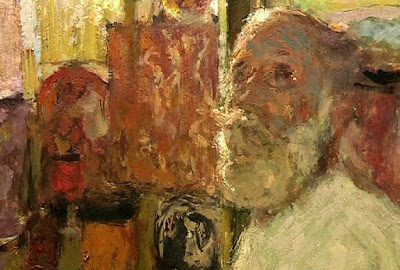Édouard Vuillard, in full Jean-Édouard Vuillard (born November 11, 1868, Cuiseaux, France—died June 21, 1940, La Baule), French painter, printmaker, and decorator who was a member of the Nabis group of painters in the 1890s. He is particularly known for his depictions of intimate interior scenes.
Vuillard studied art from 1886 to 1888 at the Académie Julian and the École des Beaux-Arts in Paris. In 1889 he joined a group of art students that included Maurice Denis, Pierre Bonnard, Paul Sérusier, Ker-Xavier Roussel, and Félix Vallotton. They called themselves the Nabis (Hebrew for “Prophets”), and they drew their inspiration from the Synthetist paintings of Paul Gauguin’s Pont-Aven period. Like Gauguin, the Nabis advocated a symbolic, rather than a naturalistic, approach to colour, and they usually applied their paint in ways that emphasized the flat surface of the canvas. Their admiration of Japanese woodcuts, which were then in vogue in Europe, inspired them to use simplified shapes and strong contours.
Vuillard studied art from 1886 to 1888 at the Académie Julian and the École des Beaux-Arts in Paris. In 1889 he joined a group of art students that included Maurice Denis, Pierre Bonnard, Paul Sérusier, Ker-Xavier Roussel, and Félix Vallotton. They called themselves the Nabis (Hebrew for “Prophets”), and they drew their inspiration from the Synthetist paintings of Paul Gauguin’s Pont-Aven period. Like Gauguin, the Nabis advocated a symbolic, rather than a naturalistic, approach to colour, and they usually applied their paint in ways that emphasized the flat surface of the canvas. Their admiration of Japanese woodcuts, which were then in vogue in Europe, inspired them to use simplified shapes and strong contours.
Vuillard lived with his widowed mother, a seamstress, until her death, and many of his works deal with domestic and dressmaking scenes set in his mother’s bourgeois home. In the paintings and prints of his Nabi period, he often created flattened space by filling his compositions with the contrasting rich patterns of wallpaper and women’s dresses, as seen in paintings such as Woman Sweeping (1899–1900). Because of their focus on intimate interior scenes, both Vuillard and Bonnard were also called Intimists.Vuillard’s Public Gardens (1894), a series of nine vertical decorative panels, is characteristic of his mature work as a Nabi. As was common among the artists in the group, who supported the idea of art as decoration, Vuillard was commissioned to create this series as panels to be installed in a private home. In these panels, Vuillard portrayed women and children in the public gardens of Paris. He avoided modeling; instead, he applied the paint in distinct areas of patterned colours—soft shades of green, blue, and brown—producing a two-dimensional, tapestry-like effect.
In addition to painting, Vuillard, like most of the other Nabis, was involved in book illustration, poster design, and designs for the theatre. In 1893 Vuillard helped found Aurélien Lugné-Poë’s Théâtre de l’Oeuvre, which produced Symbolist plays. Vuillard designed stage sets and illustrated programs.
In 1899 the Nabis exhibited together for the last time. That year Vuillard began to paint in a more naturalistic style. He also executed two series of masterful lithographs that reveal his great debt to Japanese woodcuts. Vuillard continued to receive numerous commissions to paint portraits and decorative works for private patrons as well as for public buildings. Over the course of nearly 15 years beginning in 1923, he painted intimate portraits of his artist friends Bonnard, Roussel, Denis, and sculptor Aristide Maillol, each portrayed at work in his studio. His public paintings included the decorations in the foyer of the Théâtre des Champs-Élysées (1913) and murals in the Palais de Chaillot (1937) and in the League of Nations in Geneva (1939).
In 1899 the Nabis exhibited together for the last time. That year Vuillard began to paint in a more naturalistic style. He also executed two series of masterful lithographs that reveal his great debt to Japanese woodcuts. Vuillard continued to receive numerous commissions to paint portraits and decorative works for private patrons as well as for public buildings. Over the course of nearly 15 years beginning in 1923, he painted intimate portraits of his artist friends Bonnard, Roussel, Denis, and sculptor Aristide Maillol, each portrayed at work in his studio. His public paintings included the decorations in the foyer of the Théâtre des Champs-Élysées (1913) and murals in the Palais de Chaillot (1937) and in the League of Nations in Geneva (1939).
Vuillard retained an Intimist sensibility for his entire career; even when painting portraits and landscapes, he instilled his compositions with a sense of quiet domesticity. In the early 20th century, when European art was influenced by the development of avant-garde styles such as Cubism and Futurism, many critics and artists viewed Vuillard as conservative. Paintings from his Nabi period received the most popular and critical approval, with critics often dismissing his later work. However, in the late 20th century, historians and critics began to devote more attention to Vuillard’s achievements as a decorative painter and designer.Encyclopædia Britannica








No comments:
Post a Comment